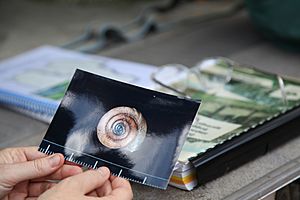Boggomoss snail facts for kids
Quick facts for kids Boggomoss snail |
|
|---|---|
 |
|
| Photograph of a preserved shell of Adclarkia dawsonensis | |
| Conservation status | |
| Scientific classification | |
| Genus: |
Adclarkia
|
| Species: |
dawsonensis
|
Adclarkia dawsonensis, also known as the boggomoss snail or Dawson Valley snail, is a special type of land snail. It breathes air and lives on land. This snail is a mollusk and belongs to the Camaenidae family.
Adclarkia dawsonensis was the first species discovered in its group, called Adclarkia. You can find this snail in the Taroom area of Queensland, Australia.
The snail's name, dawsonensis, comes from the Dawson River valley. This is the area where the snail lives. A scientist named John Stanisic discovered this snail. He worked at the Queensland Museum. He officially described the species in 1996.
Where the Snail Lives
Currently, we know of only two places where Adclarkia dawsonensis snails live. Both locations are in the Taroom area.
One group of snails lives on Mt Rose Station. This is private land. They live in three special wet, boggy areas called boggomosses. Scientists believe there are more than 350 snails here. These three areas were likely connected before the land around them was cleared for farming.
The second group lives near the Dawson River. This area is a camping and water reserve. It is located between the towns of Taroom and Theodore. About 500 snails live in this riverside area.
Scientists think these snails used to live in many more places. However, their homes have been destroyed, which has greatly reduced where they can be found.
There was a plan to build the Nathan Dam. This dam would have flooded some of the snail's homes on Mt Rose Station. In 2009, a project tried to move some snails to new safe places. Later, more studies found many more snails (around 18,000) in other areas. This reduced worries about the dam's impact on the species. However, the Queensland Government still lists the snail as "endangered" in Queensland. This means it is at high risk of disappearing.
What the Snail Looks Like
The shell of the Adclarkia dawsonensis snail is quite thin. It is also somewhat see-through. The shell is shaped like a spiral. Its color can be light brown or greenish-yellow. Sometimes, it has a thin red band near the top and a small red spot near the center.
The shell has about 5 to 5.5 spirals, called whorls. The last spiral slowly slopes downwards. The very top of the shell is only slightly raised. The opening of the shell is nearly round. The edge of this opening is white and slightly turned outwards.
The center hole of the shell, called the umbilicus, is small. It measures about 2.3 to 3.2 millimeters wide. Part of this hole is covered by the widened edge of the shell's central column. The whole shell is about 21.6 to 25.7 millimeters wide. It is about 14.5 to 16.6 millimeters tall.
The shell surface looks smooth. But if you look very closely with a microscope, you can see tiny ridges. These ridges have fine, long scales on fresh shells.
The snail's body itself can have different colors. It might be light brown or white. It often has varying amounts of grey on its neck, sides, and tail. You can also see distinct black spots on the snail's lung roof through its shell.
- Department of the Environment (2016). "Adclarkia dawsonensis" in Species Profile and Threats Database, Department of the Environment, Canberra.


